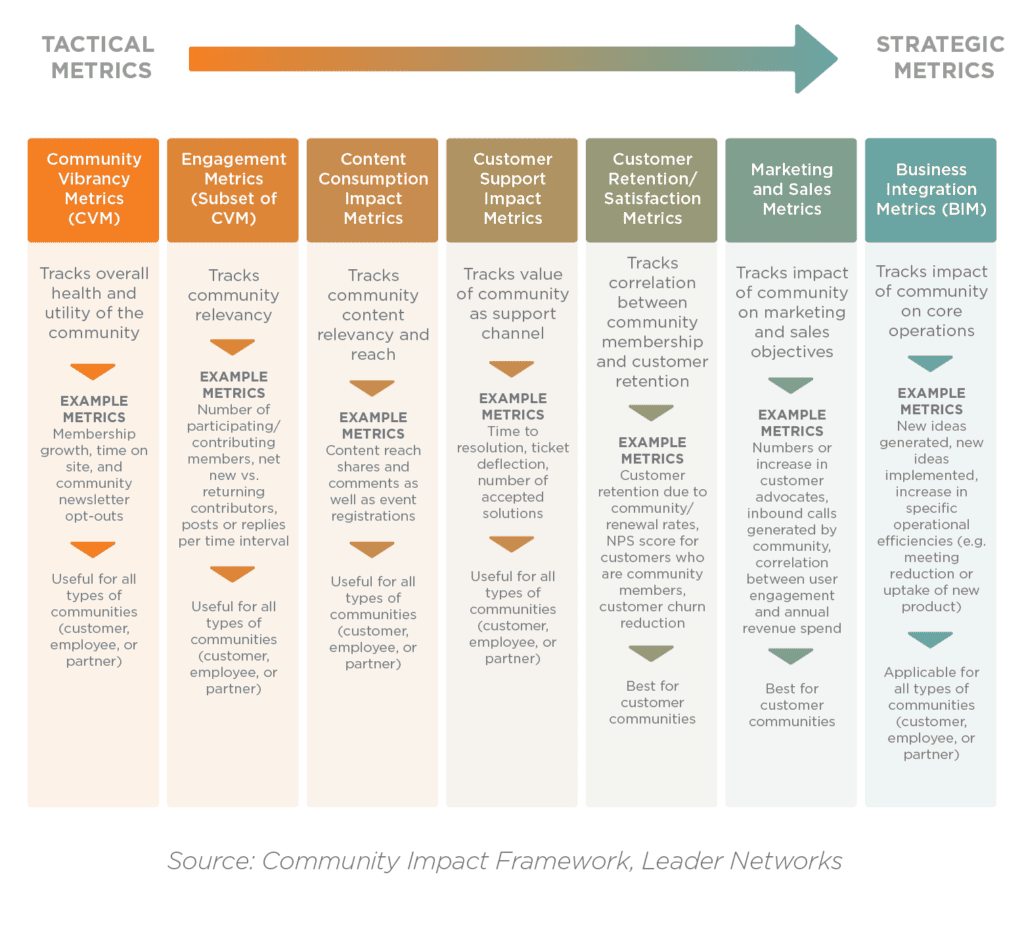
The Community Manager’s Guide to Understanding Community Analytics
If you want to grow your online community, develop a strategic approach to tracking your community’s analytics.
If you want to understand what community engagement tactics are working so you can grow your online community’s participation, budget, and staff, having a strategic approach for measuring your online community’s analytics is key. Fortunately, most online community platforms include dashboards that collect data and display metrics for you, so you should have a good baseline.
But even with these tools, you might be wondering: How do I know what the important community management metrics are?
The same general principles of goal-setting and metrics-tracking used for most strategic planning are also true here. Start at the top and work your way down:
- What are your organization’s goals?
- What are your team’s goals?
- What are your community’s goals, and what metrics can you measure to prove you’re achieving those goals?
Once you have your goals established, you’re ready to dive into tracking your community’s analytics.
Categories of Community Analytics You Can Measure
First, you should understand the two categories of community analytics:
- Engagement metrics: metrics you’ll generally find within the community platform, like logins, discussion activity, etc.
- Business metrics: metrics you’ll find by looking at broader business numbers, like retention rate, event registration, etc.
You’ll want to measure both engagement metrics and business metrics. Engagement metrics measure how active your community is, while business metrics measure the business impact of the community.
Leader Networks illustrates it like this in their Community Impact Framework. The first three metrics showcase engagement metrics, while the last four showcase business metrics.

As you come up community key performance indicators (KPIs), make sure you’re matching them to your goals. For example: if you want to increase your retention rate look at how you currently measure retention, then create new KPIs that will help you measure how this is influenced by your community. Some sample business metrics you might use include:
- Improve retention
- Retention rate of those who engage in the community vs. those who don’t, year over year.
- Average lifetime value of those who engage in the community vs. those who don’t, year over year.
- Increase satisfaction and advocacy
- Average Net Promoter Score of those who engage in the community vs. those who don’t.
- Increased event registration
- Number of event registrations for events promoted within the community vs. not.
- Frequency of event registration for users who engage with the community vs. don’t.
As you go, you’ll want to define baseline KPIs (where are you now) and target KPIs (where you want to be).
Understanding Online Community Engagement Metrics
We won’t get into business metrics in-depth here because your organization’s goals – and the metrics you need to track against those – will vary. But engagement metrics will tell you how successful your community is by helping you understand how many people create, respond, and interact with content.
There are two keys to measuring engagement:
- Measure on a regular basis: You’ll need to measure engagement on a regular basis in order to see how your community is doing over time. While you can measure engagement on a monthly basis, we recommend measuring at least quarterly. A user’s engagement may vary a lot month-to-month, but much less if you look at it on a quarterly basis.
- Measure the right things: You won’t be able to gain insights unless you measure the right metrics. What do we mean by the “right” metrics? They’re the metrics that map to your goals. For example, if one of your goals is to provide a resource hub, you’ll want to measure how often resources in your community library are being downloaded. These measurements will help you evaluate whether the community is actually being used and relied on.
13 Community Engagement Analytics to Track
These are the engagement metrics you may be able to track in your community reporting dashboard, depending on your online community platform.
Community retention and use
1. Total logins vs. unique logins
Total logins are a little bit of a vanity metric – what does that number really tell you? Sure, you know the number of times the login button has been pushed, but who are those people? Logins versus unique logins paints a bigger picture. Rather than just seeing the number of times people logged into your community, by comparing logins to unique logins, you can discover how many different people logged in. Are many users logging in once or twice a month and not coming back? Or is it a handful of diehards who log in every day, multiple times a day? That means they’re essentially carrying the login number themselves.
When you compare total logins to unique logins, you get a fuller picture of your community activity and determine whether you need a plan to market your community and attract new users.
2. Unique contributors
Understanding how many individual users are joining discussions and engaging with your community can help you monitor overall activity levels and see if there are new faces in the crowd. New people mean fresh content in your community, so you want to see the number of first-time posters increase each month. It shows that your community is growing and people feel welcomed.
3. Agreed to terms
More than just joining your community, you want to make sure users can actually USE it. Seeing who’s new and who has agreed to terms can help you get a sense of how many new people join each month and how many follow-through on signing off on your community terms.
Your total number of users can stay the same over a long period of time or slowly increase. But that doesn’t mean you’re only adding people – people may opt out or withdraw from the community at the same rate (or similar rate) as people joining. If that’s the case, then only looking at total members doesn’t help you very much.
That’s one reason should continually review how many people agreed to terms and compare it to the total number of members. Not only do you see how many people join your community each month, but it illuminates how many people leave each month.
Consumption
4. Top pageviews
What page or pages get the most pageviews? Is it always the same one or does it change every month, quarter, or year? By monitoring your top pageviews you can keep an eye on what topics are popular, or which posts create the most engagement. If you publish this each month within your community, you may even be able to kindle a little healthy competition and spur more general activity.
This is also a great stat to share with internal stakeholders – what are your users actually interested in?
5. Types of community members
All communities have a combination of different types of members. There are:
- Creators
- Users who create posts, blogs, and other new content.
- Contributors
- Users who reply to or comment on the created content.
- Consumers
- Users who exclusively view or log in to consume the created content and its contributions.
- Inactive
- Users who have not made any actions in the community in the last year.
Monitoring the number of each type of member and whether that goes up or down each month can inform your engagement strategy and whether you and members are posting enough content that’s designed to engage.
6. Average number of active members
Once users log into your community, how many of them actually participate? In order to get this number, first you have to define what ‘active’ is for your community. For example, an active member could be someone who does one (or more) of these actions: recommends or reacts to a post, posts a new discussion, replies to a thread, uploads a document or image, writes a blog post, volunteers for an activity, etc.
Once you define what ‘active member’ means to you, you can begin tracking those people and create a bigger picture of who your contributors are. So, every month, X people log in, Y are new, and Z actually participate once they’re inside. That information can tell you a lot about who your community appeals to and where you should focus.
Engagement
7. Discussion posts
What’s the top discussion post every week, month, or quarter? Like pageviews, this can tell you what are the hottest topics for your organization so you can focus in or provide more information about them.
8. Library uploads
What kinds of resources are people sharing with each other? What topics do they cover? Seeing what users add to the library is a great place to answer this question, and it’s another form of business intelligence you can gain from your community.
9. Average number of responses per post
When you first start a community, people can be slow to engage. Ensuring someone replies to each post can take some prodding, which is often labor-intensive for the community manager. As the community grows and people become more comfortable contributing, this number will rise. This is not only rewarding for the community manager, but for your community members, too – as this number rises, it means more people are taking ownership and the community is growing organically.
With a Higher Logic Thrive Community, some users like to assess engagement using our Engagement Benchmark Score. The score provides a summary of three indicators – activity, value, and reach – and a letter grade, along with tips for how you can improve in each area.
10. Average number of posts per day
This number can vary frequently, and that variance can tell you a lot. Look at the daily number and think: What days of the week are most active? What time of the day/month/year lags? Which groups should we consider closing or trying to revitalize? This number will help you predict when you’ll have to work harder to keep your community going (maybe August is everyone’s vacation time) and what times of year the community is better at sustaining itself.
11. Message origination type
How are members engaging? Are they replying through email or actually logging into the community site to reply to a thread? This offers insight into member behavior – are people only reading digests or browsing through the entire community? For example, if most people only respond through email, this says something – maybe email is a pretty effective way of engaging them.
Perception
12. Quotes/comments from users
Your success measures don’t only have to be quantitative – the anecdotal, qualitative data is helpful, too. For example, if your community members post about how grateful they are for the community and how it’s been the best part of their job, etc. – save those! Use them to demonstrate success and value-added in a real way.
13. Emails to you
Similarly, if you get emails thanking you for the community and letting you know what a great resource it’s been, keep them and use them to demonstrate success. Your success shouldn’t only be based on anecdotes, but it’s a great way to add color and social proof to your efforts.

4 Reasons Community Managers Should Lean into Data and Analytics
As a community manager, you’ve learned that community management is made up of many different parts. It’s an interdisciplinary field involving tactics like people skills, psychology, strategy and analytics, to name a few. There can be a lot to juggle, and if you’re not a numbers person, one of the most daunting tasks can be tracking data and analytics—too many balls in the air, right?
Yet, even with the data easily accessible in your community platform, it can be tempting to ignore or under-utilize this incredible tool. Maybe you’ve never been trained to analyze data; maybe you don’t feel like you have time. But measuring the data, tracking your success, and using it to prove how your community is advancing the organization’s broader initiatives will give your community a strong strategic footing.
- Increase engagement: Data shows you exactly what is and isn’t working, so rather than posting things in the dark, hitting some and missing others, use your data to confirm the direction you’re taking is right (or wrong). Make it an experiment. Before starting a new discussion thread, predict what will happen – hypothesize. When the results roll in, think about why your experiment turned out the way it did and adjust if you need to. Hopefully, after some trial and error, you’ll learn what people respond to, if it matters what time of day you post, etc.
- Grow your community: Increasing engagement and growing your community go hand in hand – the more engaged your community, the more it grows. That’s one reason why using data to increase engagement is so important – the ripple effect it has can have a positive impact on other aspects of your community, such as growth. Don’t just look at numbers alone; context is important. What good are 100 discussions posted in one month if you have nothing to benchmark it against? Think about the bigger picture and how the numbers connect. When you sent out that email blast, did more people join or did some discontinue? Are the daily digests helping bring people back into the fray and become connected? Your data will provide important insight into all these questions.
- Be proactive, not reactive: Sometimes it can feel as if you’re constantly reacting to surprises within your community. Part of community management is coming up with a strategy, and subsequently using data to inform your decision making. When you have data, you can establish goals, create an action plan, set metrics and hold yourself accountable. This will give you a greater control and make your community more stable.
- Prove return on investment (ROI): At the end of the day, being able to prove ROI is an incredibly important thing for a community manager to do – both to maintain buy-in and grow your program and the resources behind it. How does data play into this? By tracking retention, level of activity, and community membership cycle, you’ll have a strong set of information that shows how important your community is to your members. If the numbers are good and there is high retention, a lot of activity, and membership longevity, you can prove the high ROI that the community brings to your organization.
You’ll also see what members are most interested in, what their concerns are, and if they’re turning to each other for information, among other things. This helps your organization better understand their members and provide meaningful support and services to them.
How to Share Your Community’s Success
Now that you have a list of metrics to start, who should you share it with? There are certain groups who would be interested and benefit from your analysis:
- Share internally with your team in a monthly report. This way everyone is on the same page and can track the community’s ups and downs. They may have interesting insight into the trends you’re tracking and suggestions for why certain numbers fluctuate.
- Set up a meeting once a quarter with leadership and invested stakeholders to show where your community is doing well, where it could be improved, and your plan to improve it. Since your online community is a goldmine of data and user-generated feedback, try providing relevant insight to each department. For example, if your community members are talking a lot about a certain subject, share that with your marketing team – this is valuable information they can use in upcoming marketing campaigns.
- Share statistics that certain community members may find interesting. They don’t need to know the intricacies of what’s going on, but some basic stats could excite and encourage more activity. By posting the most active discussion group or highlighting community champions, you create a healthy sense of competition amongst members. If you hit a milestone or are especially excited about one metric – you hit your 1000th member or found the longest thread in your community’s history – let your members be part of the celebrations.
In addition to growing community activity, measuring member behavior helps demonstrate return on investment (ROI), which is an important part of a community manager’s job. If you don’t have numbers and metrics to back up the health of the community, you won’t be able to demonstrate ROI and community value.
There you have it – a community manager’s guide to tracking analytics. If you’re not sure which analytics to track or want to build a strong strategy for your community, check out how these organizations used dedicated community management to improve.


